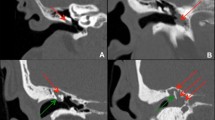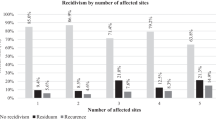Abstract
Purpose
Limited literature exists on primary external auditory canal (EAC) cholesteatoma (EACC). Here, we focus on the clinical features of this rare disease, especially the invasive patterns of lesion progression, through a large population study and present simple and practical staging.
Methods
In all, 276 patients (male 99; female 177; mean age 41.3 ± 21 years; ears 301) with primary EACC were retrospectively analyzed. Stage I indicated EACC without bony lesions, stage II indicated invasion confined within EAC, stage III indicated invasion beyond the EAC involving mastoid air cells or tympanic cavity, but within the temporal bone, and stage IV indicated invasion beyond the temporal bone.
Results
In all, 41, 219, 40, and 1 ear with Stage I, II, III, and IV lesions were found, respectively. Common clinical symptoms were hearing loss (237 ears, 78.7%), otalgia (221 ears, 73.4%), and otorrhea (85 ears, 28.2%). The mean air conduction and air-bone gaps were 45.4 ± 17.9 dB HL and 24.6 ± 15 dB HL, respectively. EACCs were found to invade in all directions of the EAC, with the inferior wall (224 ears, 74.4%) > posterior wall (207 ears, 68.8%) > anterior wall (186 ears, 61.8%) > superior wall (86 ears, 28.6%) invasion; multiwall invasions (207 ears) were common; however, inward invasions into the tympanic cavity were rare.
Conclusion
Primary EACCs occurred mostly in women and often unilaterally invaded multiple bony walls in the lower half of the EAC. The present staging reflects the patterns and severity of lesion progression and may be beneficial in treatment planning.





Similar content being viewed by others
References
Toynbee J (1850) Specimens of molluscum contagiosum developed in the external auditory meatus. Lond Med Gaz 11:811
Piepergerdes JC, Kramer BM, Behnke EE (1980) Keratosis obturans and external auditory canal cholesteatoma. Laryngoscope 90(3):383–391. https://doi.org/10.1002/lary.5540900303
Konishi M, Iwai H, Tomoda K (2016) Reexamination of etiology and surgical outcome in patient with advanced external auditory canal cholesteatoma. Otol Neurotol 37(6):728–734. https://doi.org/10.1097/mao.0000000000001079
Naim R, Linthicum F Jr, Shen T, Bran G, Hormann K (2005) Classification of the external auditory canal cholesteatoma. Laryngoscope 115(3):455–460. https://doi.org/10.1097/01.mlg.0000157847.70907.42
Hertz J, Siim C (2018) External auditory canal cholesteatoma and benign necrotising otitis externa: clinical study of 95 cases in the Capital Region of Denmark. J Laryngol Otol 132(6):514–518. https://doi.org/10.1017/S0022215118000750
Greene LD (1933) Cholesteatoma-like accumulations in the external auditory meatus. Arch Otolaryngol Head Neck Surg 18(2):161–167. https://doi.org/10.1001/archotol.1933.03580060175003
Anthony PF, Anthony WP (1982) Surgical treatment of external auditory canal cholesteatoma. Laryngoscope 92(1):70–75. https://doi.org/10.1288/00005537-198201000-00016
Owen HH, Rosborg J, Gaihede M (2006) Cholesteatoma of the external ear canal: etiological factors, symptoms and clinical findings in a series of 48 cases. BMC Ear Nose Throat Disord 6(1):1–9. https://doi.org/10.1186/1472-6815-6-16
Vrabec J, Chaljub G (2000) External canal cholesteatoma. Am J Otol 21(5):608–614. https://doi.org/10.1097/00129492-200203000-00028
Dubach P, Häusler R (2008) External auditory canal cholesteatoma: reassessment of and amendments to its categorization, pathogenesis, and treatment in 34 patients. Otol Neurotol 29(7):941–948. https://doi.org/10.1097/MAo.0b013e318185fb20
Dubach P, Mantokoudis G, Caversaccio M (2010) Ear canal cholesteatoma: meta-analysis of clinical characteristics with update on classification, staging and treatment. Curr Opin Otolaryngol Head Neck Surg 18(5):369–376. https://doi.org/10.1097/MOO.0b013e32833da84e
Hn U, Prasad SC, Russo A, Grinblat G, Sanna M (2018) Cholesteatoma of the external auditory canal: review of staging and surgical strategy. Otol Neurotol 39(10):e1026-1033. https://doi.org/10.1097/MAO.0000000000001972
Holt JJ (1992) Ear canal cholesteatoma. Laryngoscope 102(6):608–613. https://doi.org/10.1288/00005537-199206000-00004
Shin SH, Shim JH, Lee HK (2010) Classification of external auditory canal cholesteatoma by computed tomography. Clin Exp Otorhinolaryngol 3(1):24–26. https://doi.org/10.3342/ceo.2010.3.1.24
Chang J, Choi J, Im GJ, Jung HH (2012) Dilute vinegar therapy for the management of spontaneous external auditory canal cholesteatoma. Eur Arch Otorhinolaryngol 269(2):481–485. https://doi.org/10.1007/s00405-011-1676-x
Committee on Hearing and Equilibrium (1995) Committee on hearing and equilibrium guidelines for the evaluation of results of treatment of conductive hearing loss. Otolaryngol Head Neck Surg 113(3):186–187. https://doi.org/10.1016/S0194-5998(95)70103-6
Naim R, Linthicum FH (2004) External auditory canal cholesteatoma. Otol Neurotol 25(3):412–413. https://doi.org/10.1097/00129492-200405000-00035
Persaud RA, Hajiof D, Hevasagayam MS, Wareing MJ, Wright A (2004) Keratosis obturans and external ear canal cholesteatoma: how and why we should distinguish between these conditions. Clin Otolaryngol Allied Sci 29(6):577–581. https://doi.org/10.1111/j.1365-2273.2004.00898.x
Shinnabe A, Hara M, Hasegawa M, Matsuzawa S, Kanazawa H, Yoshida N, Iino Y (2013) A comparison of patterns of disease extension in keratosis obturans and external auditory canal cholesteatoma. Otol Neurotol 34(1):91–94. https://doi.org/10.1097/MAO.0b013e318277a5c8
Park SY, Jung YH, Oh JH (2015) Clinical characteristics of keratosis obturans and external auditory canal cholesteatoma. Otolaryngol Head Neck Surg 152(2):326–330. https://doi.org/10.1177/0194599814559384
Kim CW, Baek SH, Lee SH, Kim GW, Cho BK (2014) Clinical characteristics of spontaneous cholesteatoma of the external auditory canal in children comparing with cholesteatoma in adults. Eur Arch Otorhinolaryngol 271(12):3179–3185. https://doi.org/10.1007/s00405-013-2820-6
Jahnke K, Lieberum B (1995) Surgery of cholesteatoma of the ear canal. Laryngorhinootologie 74(1):46–49. https://doi.org/10.1055/s-2007-997686
Sakalli E, Kaya D, Celikyurt C, Erdurak SC (2016) Clinical characteristics and follow-up of patients with external ear canal cholesteatoma treated conservatively. Ear Nose Throat J 95(7):269–273
He GW, Zhu ZS, Xiao WH et al (2020) Cholesteatoma debridement for primary external auditory canal cholesteatoma with non-extensive bone erosion. Acta Otolaryngol 140(7):1–4. https://doi.org/10.1080/00016489.2020.1772505
Darr EA, Linstrom CJ (2010) Conservative management of advanced external auditory canal cholesteatoma. Otolaryngol Head Neck Surg 142(2):278–280. https://doi.org/10.1016/j.otohns.2009.10.035
Lee FP (2006) Pigmented nevus of the external auditory canal. Otolaryngol Head Neck Surg 135(1):124–128. https://doi.org/10.1016/j.otohns.2005.11.027
Chawla A, Ezhil Bosco J, Lim T, Shenoy J, Krishnan V (2015) Computed tomography features of external auditory canal cholesteatoma: a pictorial review. Curr Probl Diagn Radiol 44(6):511–516. https://doi.org/10.1067/j.cpradiol.2015.05.001
Morita S, Nakamaru Y, Fukuda A, Fujiwara K, Hoshino K, Homma A (2018) Clinical characteristics and treatment outcomes for patients with external auditory canal cholesteatoma. Otol Neurotol 39(2):189–195. https://doi.org/10.1097/MAO.0000000000001659
Heilbrun ME, Salzman KL, Glastonbury CM, Harnsberger HR, Kennedy RJ, Shelton C (2003) External auditory canal cholesteatoma: clinical and imaging spectrum. AJNR Am J Neuroradiol 24(4):751–756. https://doi.org/10.1097/00002093-200304000-00014
Ho KY, Huang TY, Tsai SM, Wang HM, Chien CY, Chang NC (2017) Surgical treatment of external auditory canal cholesteatoma-ten years of clinical experience. J Int Adv Otol 13(1):9–13. https://doi.org/10.5152/iao.2017.2342
Selesnick SH, Lynn-Macrae AG (2001) The incidence of facial nerve dehiscence at surgery for cholesteatoma. Otol Neurotol 22(2):129–132. https://doi.org/10.1097/00129492-200103000-00002
Uno Y, Saito R (1995) Bone resorption in human cholesteatoma: morphological study with scanning electron microscopy. Ann Otol Rhinol Laryngol 104(6):463–468. https://doi.org/10.1177/000348949510400609
Dhingra P, Pusalkar AG (2019) Spontaneous external auditory canal cholesteatoma: case series and review of literature. Indian J Otolaryngol Head Neck Surg 72(1):86–91. https://doi.org/10.1007/s12070-019-01755-2
Acknowledgements
The authors would like to express their gratitude to Yuan Zhang and Jing Yang from the Medical Case Management and Information Department of our hospital.
Funding
This study was funded by the Health Science and Technology Program Projects of Fujian Province, China (Grant number: 2020CXB044) and the Natural Science Foundation of Fujian Province, China (Grant number: 2019J01624).
Author information
Authors and Affiliations
Corresponding authors
Ethics declarations
Informed consent
Informed consent waived because this is a retrospective study.
Institutional Review Board (IRB)
Approval IRB approval was obtained.
Ethical approval
All procedures performed in the studies involving human participants were in accordance with the ethical standards of the institutional and/or national research committee and with the 1964 Helsinki Declaration and its later amendments or comparable ethical standards.
Conflict of interest
The authors declare that they have no conflicts of interest.
Additional information
Publisher's Note
Springer Nature remains neutral with regard to jurisdictional claims in published maps and institutional affiliations.
Rights and permissions
About this article
Cite this article
He, G., Wei, R., Chen, L. et al. Primary external auditory canal cholesteatoma of 301 ears: a single-center study. Eur Arch Otorhinolaryngol 279, 1787–1794 (2022). https://doi.org/10.1007/s00405-021-06851-0
Received:
Accepted:
Published:
Issue Date:
DOI: https://doi.org/10.1007/s00405-021-06851-0




